Travel with me #120 : The Dolmabahçe Palace of Istanbul!
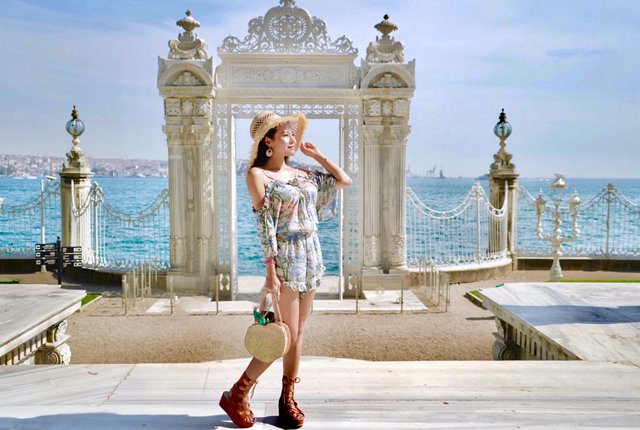
Dear Steemit Friends:
I cannot wait to share this adventure with you today. We continue our exploration of Istanbul's amazing historical and cultural buildings as we visit the Dolmabahçe Palace, home to the 31st Sultan of the Ottoman Empire Abdulmecid I. As you will see today, this beautiful palace was built to rival the luxury and elegance of the castles and chateaus of many of the aristocracy of western Europe. Abdulmecid I built this new palace and moved his family here after the thirteen year construction finally came to an end in 1856.
The Dolmabahçe Palace was the last palace in the country where a Sultan lived, because in 1922 the Republic of Turkey was formed, with the first president being elected in 1923. This effectively marked the end of the Sultanate, with the last royal to live in the palace being Caliph Abdulmecid Efendi. In 1924 the control of the royal palace passed to the national heritage of the Turkish Republic. After this time it was used by Turkey's first president, Mustafa Ataturk as a summer residence and where he also spent the last years of his life.
As you will see, the beauty of this place matches its rich history. Elaborate, ornate, well preserved and decadent, this Dolmabahçe Palace is a sight to behold. Come with me now as we explore the gorgeous stone work of this, the largest palace in Turkey.
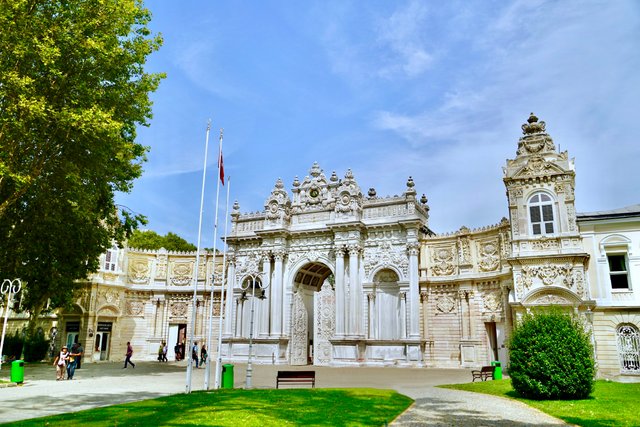
Here, at the Gate of the Treasury we get our first glimpse of the beautiful architecture of the palace. The styles that have been used in the design and construction of the palace have been described as Neoclassical and Baroque, still with plenty of hints from a more traditional Ottoman style. In art and architecture, Neoclassical has a few meanings and complexities, but in essence seeks to revive key features from classical antiquity, such as the majestic columns and white stone walls you'd see in ancient Greek architecture.
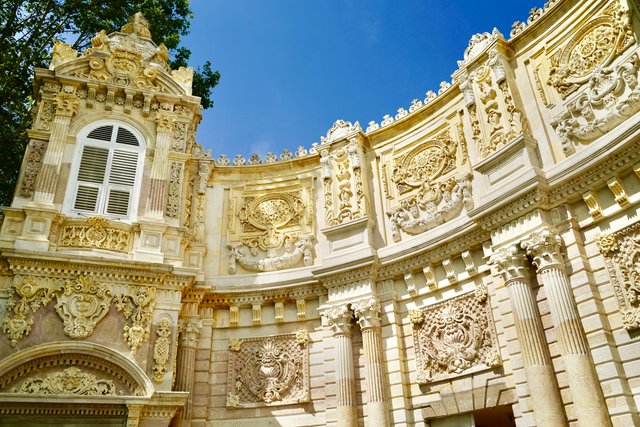
You can see how this form is then blended the more Baroque style of architecture which holds its roots in 16th century Italy, characterised by its ornate design, exploration of light and shadows in the design and for its size and drama. I'm sure architecture buffs would have a much better idea of the differences than I, all I know is that the desire to create something to rival the palaces of Italy and France, along with a budget of five million Ottoman gold lira (around 1.7 billion US dollars), created something breathe taking.
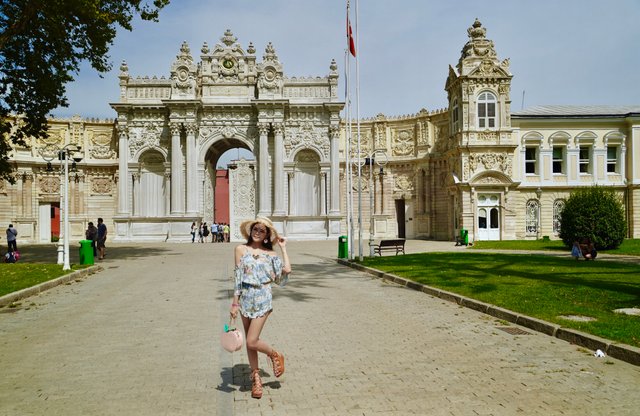
You can see from the stone work, that thousands and thousands of hours of work went into the creation of this dramatic palace. Every inch of the building is meticulously decorated, hand carved into the beauty you see today. But not only that, the Dolmabahçe Palace also gives even the largest palaces in the world a run for their money. At over 45,000m² set in 110,000m² of land, it is huge. The six Sultans that lives here between 1856 and 1924 could have slept in a different room each night and only slept in the same room three times per year.
Let me try to give you a sense of the size. There are 285 rooms in the palace itself, 6 full sized Turkish baths and 68 toilets! What could you possibly need 68 toilets for? I guess the palace was so big that it meant there was always one nearby, otherwise you might have to walk for half an hour to go to the bathroom!
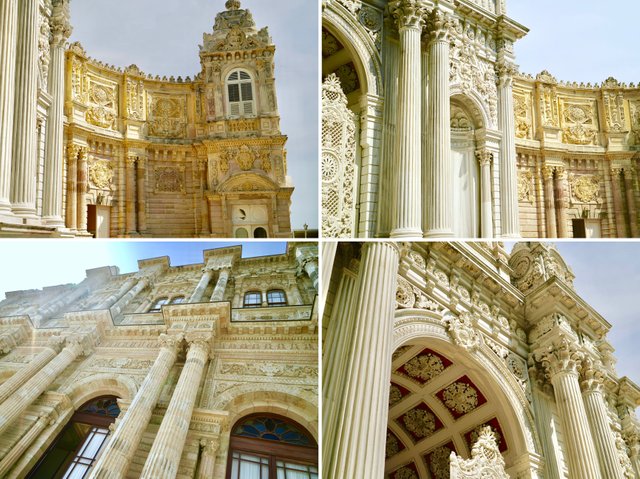
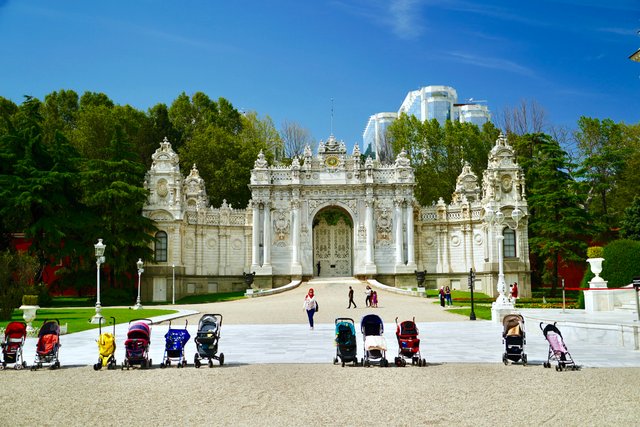
I am not sure, because I didn't have a buggy with me (surprise!), but I believe that no strollers were allowed inside the palace itself. So, what happened was this very comical line of buggies abandoned outside the gate! I hope that no-one got confused as to which one was theirs. I loved this scene because it contrasts the ornate white stone facade of the palace with the steel and glass of the modern building that you see rising up behind. Modern architecture meets classic architecture.
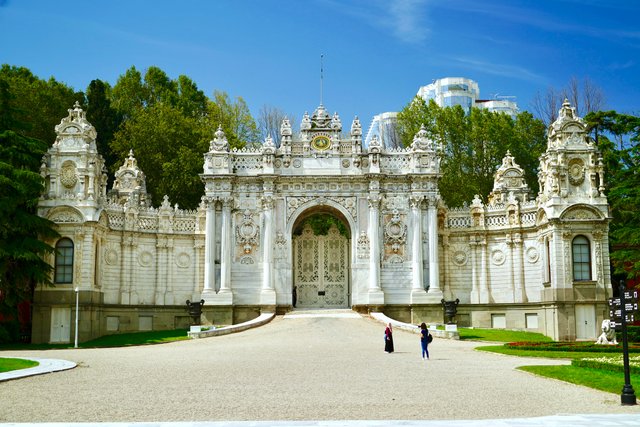
One of the most impressive features of the Gate of the Treasury is the gates themselves. Towering over six meters tall, they are beautifully carved and kept in the same impressive white as the stone work around them. It creates this illusion that perhaps the gates were also carved from the same solid white stone as the gateway around them. This makes them feel extra special, because you know how impossible and intricate it would be to carve gates like these out of stone - and of course they aren't carved from stone. They would be too heavy for their hinges and also, not very strong! They would crack. The gates here are probably made of either wood or metal but I couldn't tell because of how well maintained the paint work on them was.
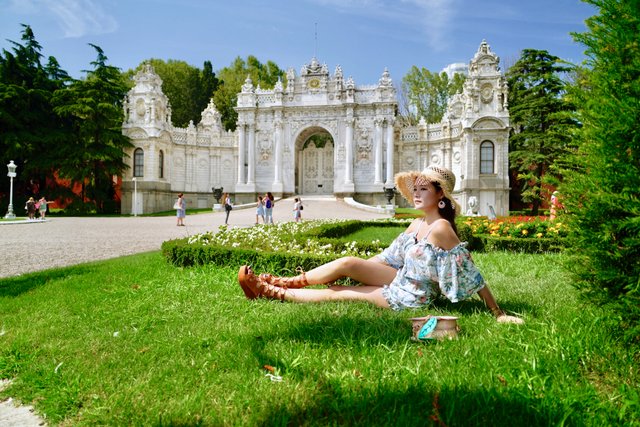
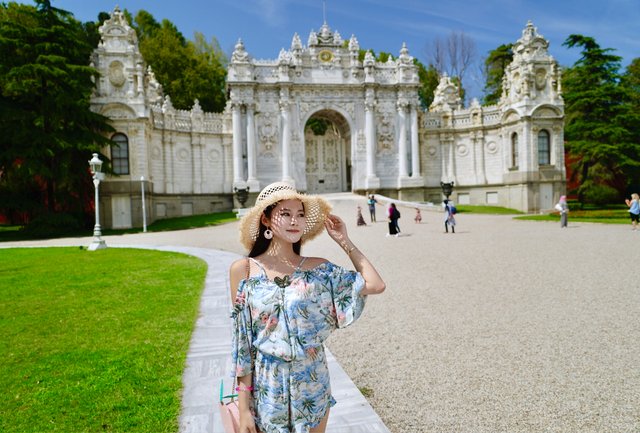
Can't get enough of that view, the architecture is some of my favourite I've seen in a European Palace. The symmetry is just amazing while the grandeur and size is hard to explain with a photo!
Inside the palace grounds and gardens
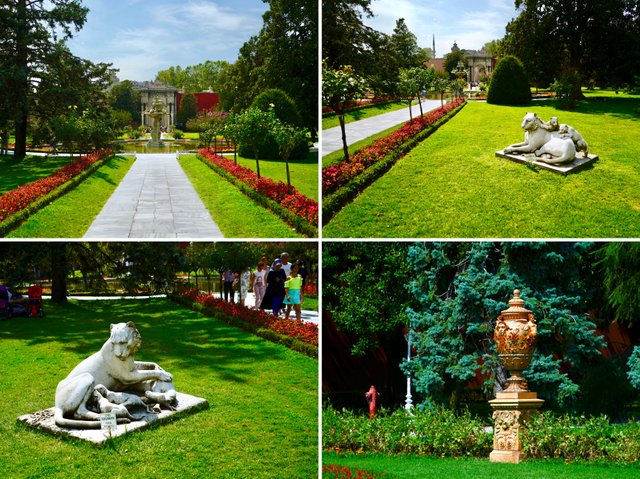
Within the gates, the grounds of the palace are extensive. They are beautifully manicured and feel like a Victorian formal garden. Plenty of straight lines, wide avenues and many water fountains and statues. There is such a range of different plants and trees, many of which you'd consider quite western European, such as fir trees. You can see how Abdulmecid I wanted to create a palace to rival the palaces of France and Italy, right down to the final details of importing similar foliage for this garden's design.
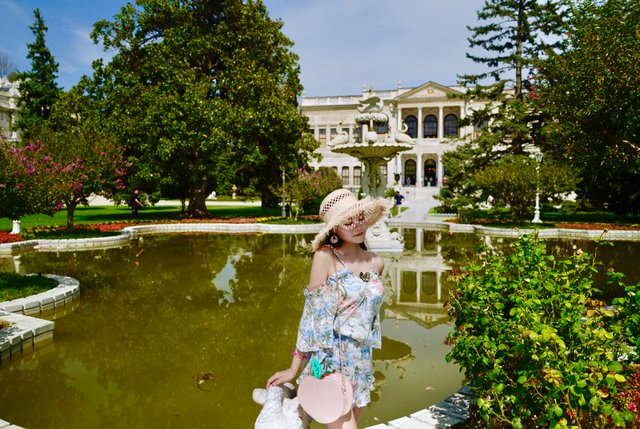
Very popular in Victorian era formal gardens were water features. They spoke of wealth, that you could have water just for decoration rather than for the important function of hydration. Obviously in much of Turkey it can get very hot in the summer so maintaining water features like this holds some extra challenges compared to having them in an English country garden - just another reflection of the lavish wealth spent on creating Dolmabahçe Palace.
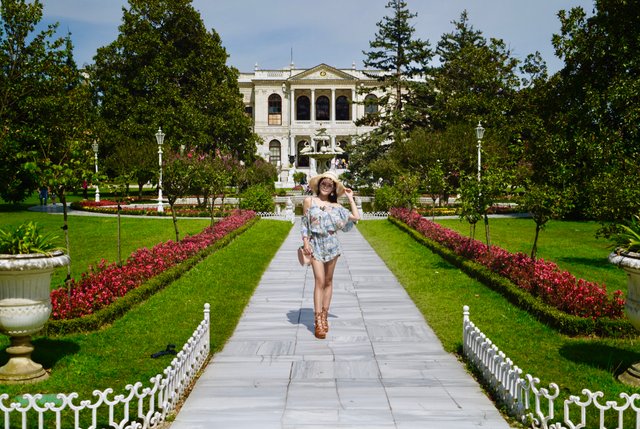
The well manicured lawns, colourful flowers, stone statues and clever planting serve to create frames of the different buildings of the palace, wherever you go. Paths lead the eye up to the front doors and pull you through the grounds to see each different building while being in the beautiful greenery. I love how the white of the building pops out from between the trees while never feeling lost.
The name Dolmabahçe literally translates to 'filled garden'. The palace is set on the Bosphorus strait, a famous waterway that marks part of the continental boundary between Europe and Asia, also separating the part of Turkey considered European Turkey with that considered Asian Turkey. It connects the Black Sea with the Sea of Marmara. And that's how the palace gets its name. Originally this area on the bank of the Bosphorus was reclaimed from the waters to create a large park area. The land was literally 'filled' to create a bigger, more stable shore line, compared to the muddy and wet area that there was before. In the 17th century this area would have been used as a place for the Ottoman fleet to drop anchor when not out at sea. The sultan obviously thought this was a beautiful location so worked to increase the structure of the land, making sure the banks of the strait wouldn't erode his gardens, and then building his palace on top!
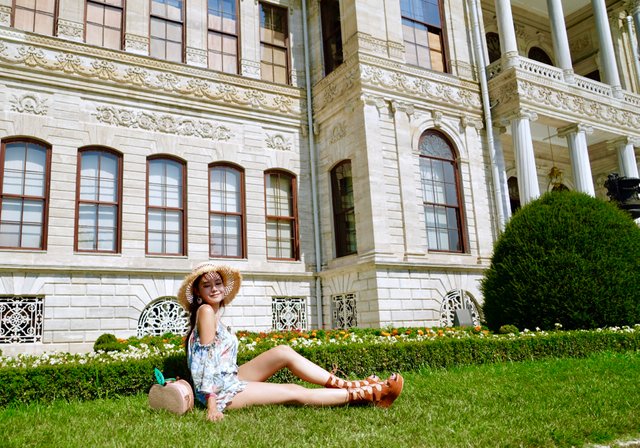
The Gate to the Bosphorus - a gateway to Asia
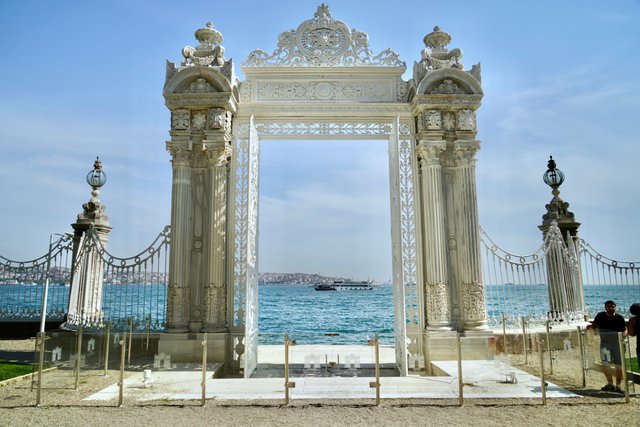
The palace itself stands on European Turkey, overlooking the Bosphorus strait onto Asian Turkey. The Gate to the Bosphorus is absolutely fascinating because it's a gate that leads to... well nothing! Or nothing in the traditional sense. It serves two purposes. The first is physical, it provided a beautiful entrance and exit for the Sultan to reach his ships down in the strait. The Ottomans maintains a strong Navy so I'm sure Abdulmecid I would have had his own ship that would dock here, ready to take him anywhere on the coast of the empire if he should need it.
The second purpose of the gate is metaphorical. Istanbul, or Constantinople as it was known for centuries, has always been considered the gateway between the European and Asian continents. Dozens of different empires and rulers coveted the city because it is built in a kind of natural bottle neck between the two continents. If a European power controlled the city, then they controlled the gateway into Asia, if an Asian or African power controlled the city, they controlled the gateway into Europe. The gate symbolises this strategic power and importance of the city.
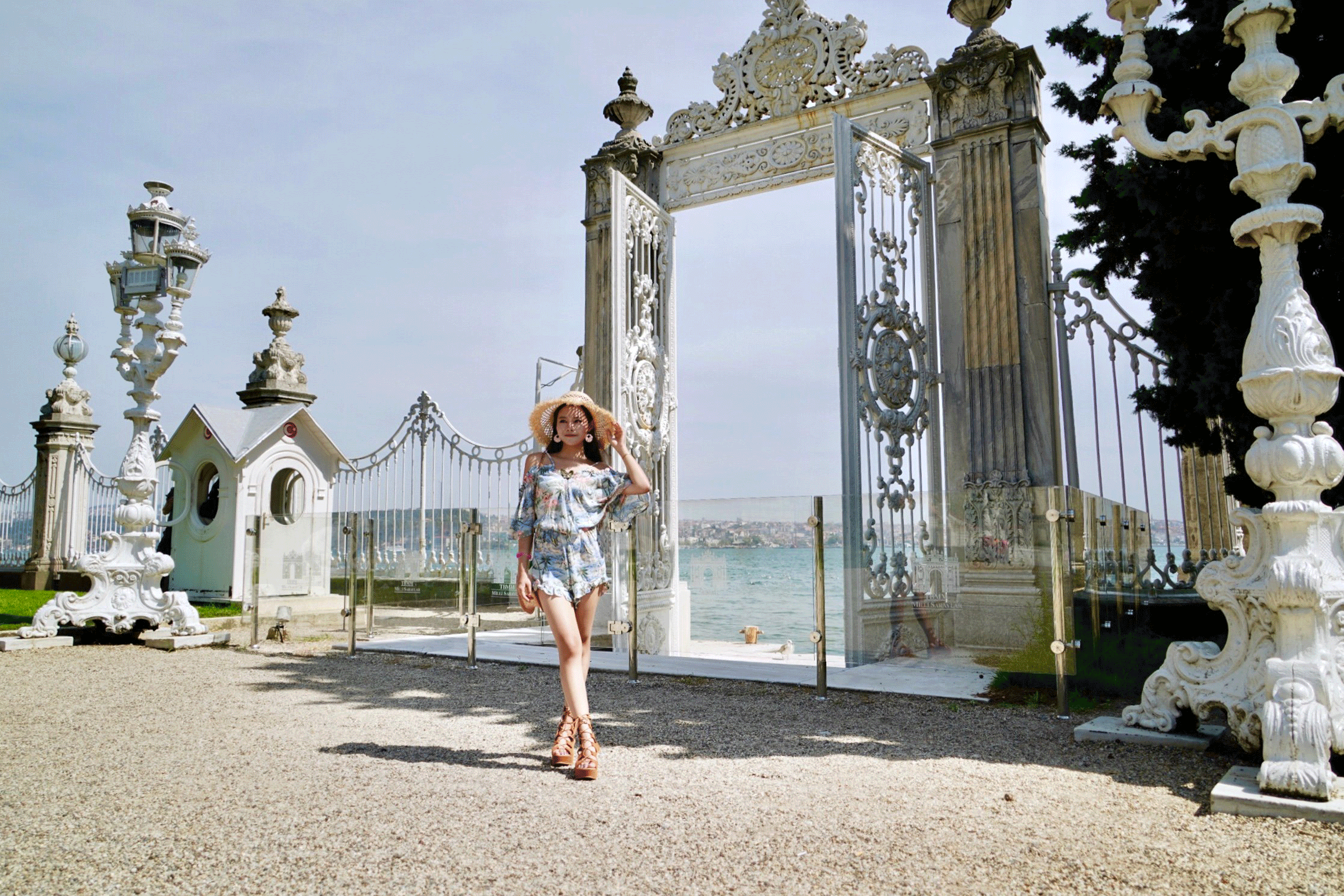
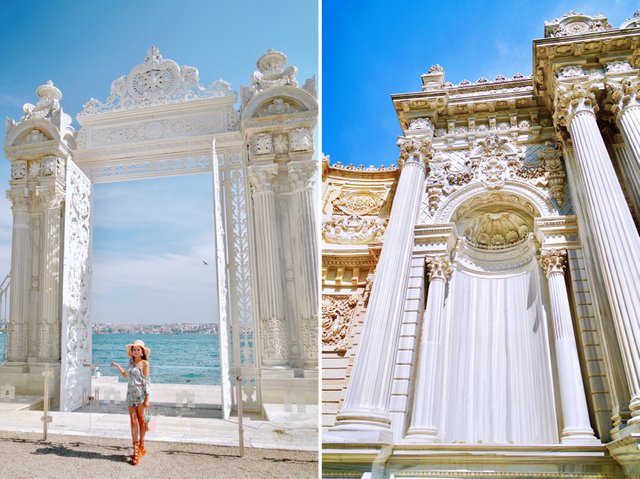
The gateway stands over 12m tall, with ornate metal work on the gates and of course, stone work on the pillars. So beautifully maintained, the sun bounces off the bright white paint of the gates, making them look almost delicate. Their designs so intricate and befitting their importance and significance to the Sultan, the city and of course, the Ottoman empire at the time.
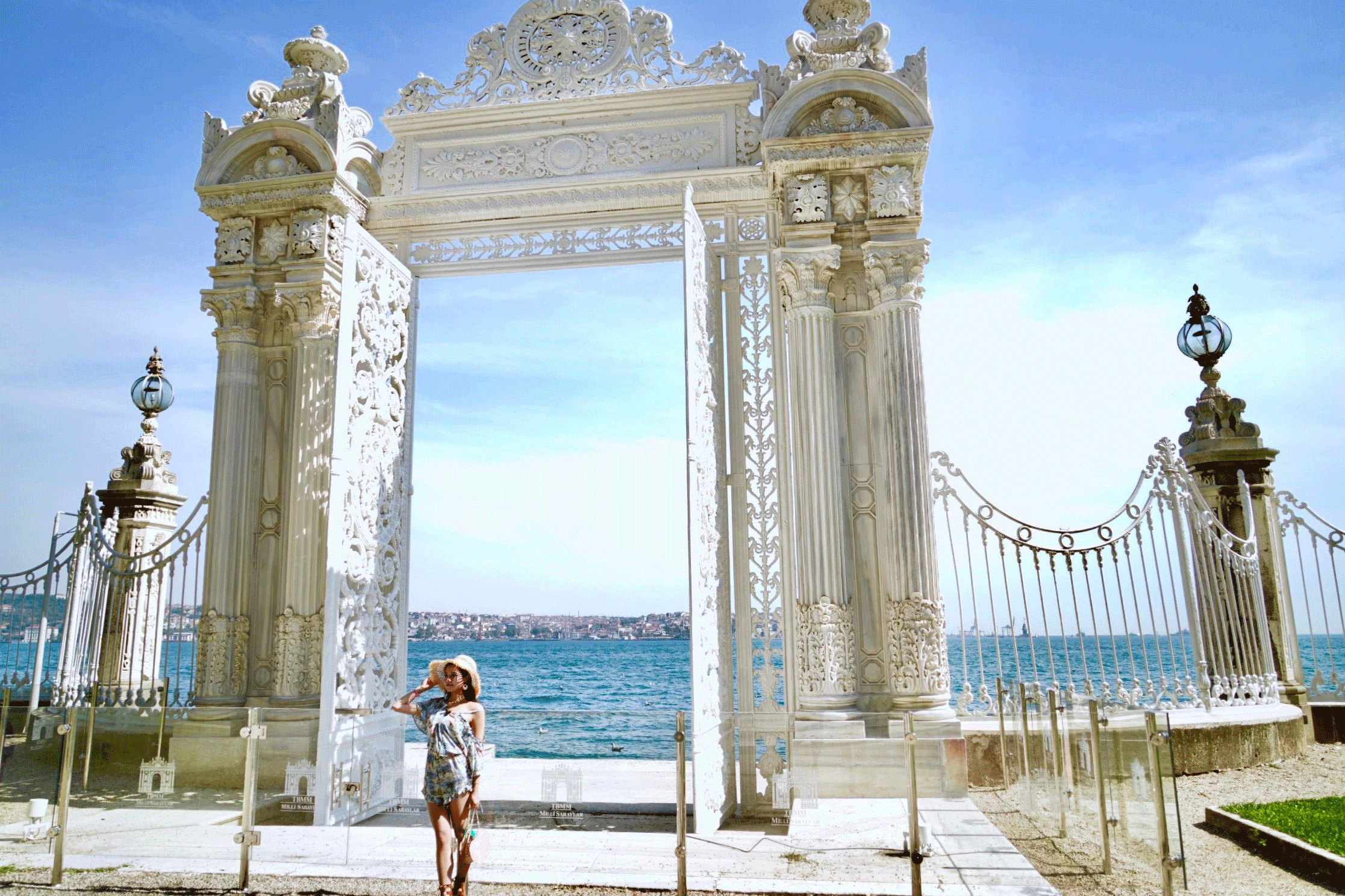
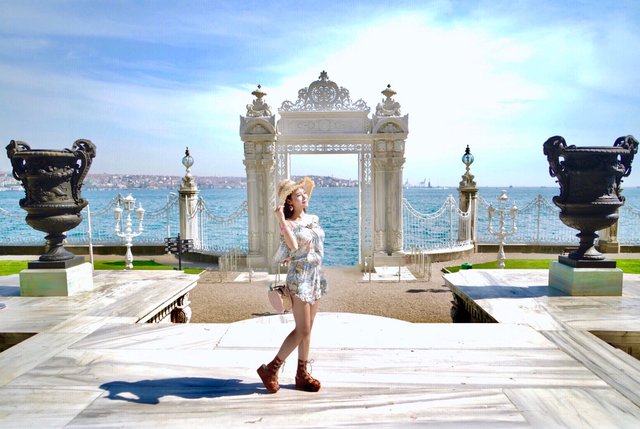
The central palace, a place of size and beauty
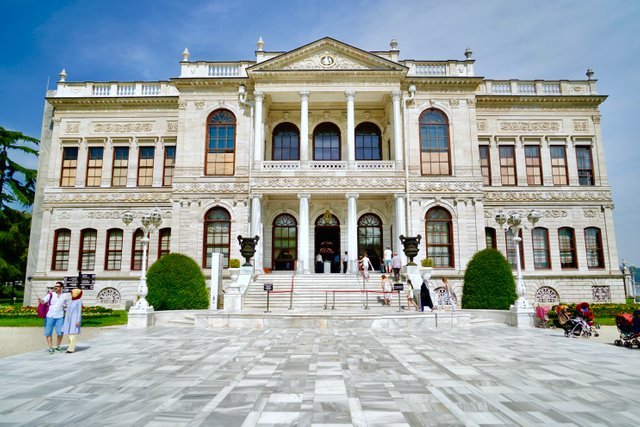
There are a few different buildings and sections within the palace grounds. There are the Administrative apartments, obviously designed for the running of the empire and the many people needed to do that, the Ceremonial Hall, the Imperial Harem and the Imperial apartments.. There are of course, many more buildings than just these such as kitchens, barracks, stables, mills, aviaries, carpet workshops and many more. The entire palace
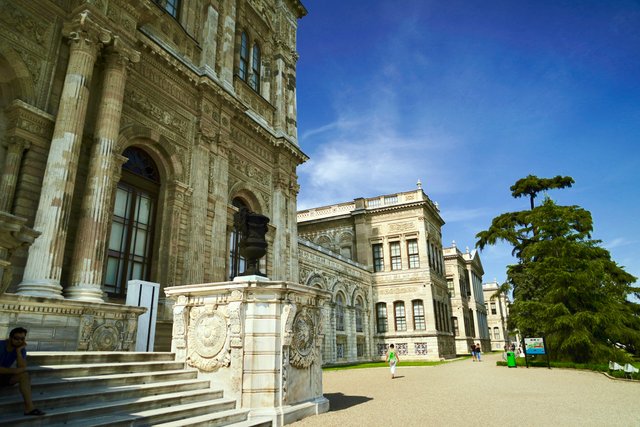
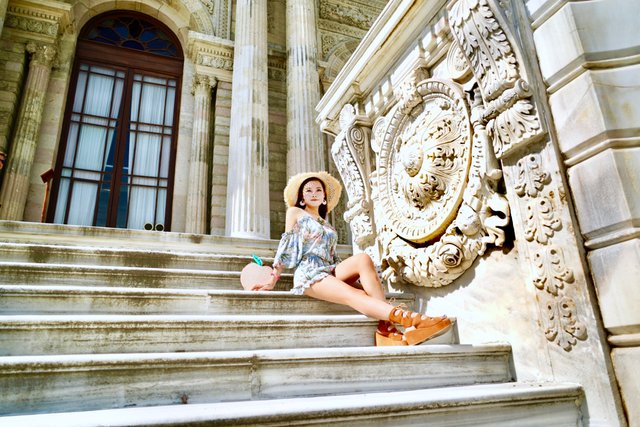
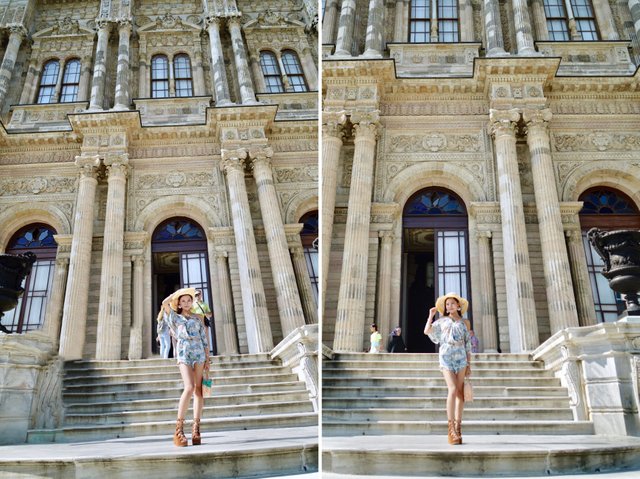
Inside, the decorations are lavish, but I will tell you now that I only have a couple of photos of them because you were not allowed to take photos within the main and most impressive rooms. You'll still see the photos from inside that I took, which were from some of the less ornate rooms - you'll see those soon! First let me tell you a bit more about the inside of the palace, since you've seen so much of the outside.
According to the information from my guide, over 14 tons of gold leaf was used to decorate the ornate ceilings and 131 silk carpets were made by hand, over the span of a decade. You are not allowed to go inside without an officially guided tour because the inside is so delicate, rare and expensive. It has many of the worlds finest examples of art work and interior design. Queen Victoria even sent a crystal chandelier as a gift which is the largest in the world, with 750 bulbs! It weighs over 4.5 tons, can you imagine trying to fix that to a ceiling?
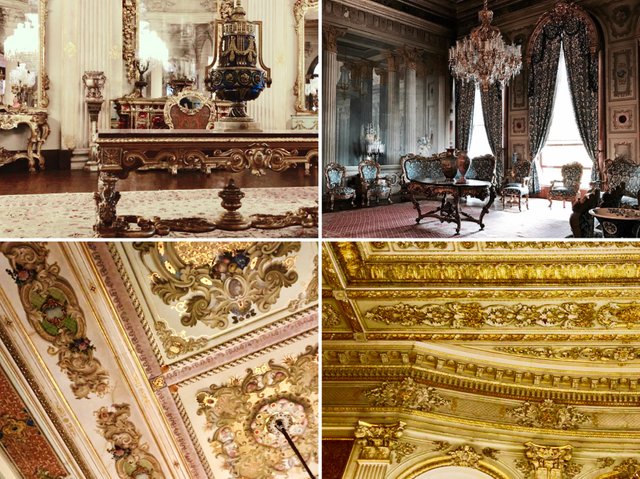
In a couple of rooms, you could take photos, where they believed the room was less important. You can see that these rooms are some of the most impressive places that you will see anywhere in the world. From the furniture to the carpets to the ceilings, it's all extravagant and truly amazing. The carvings, the decorations, everything, must have taken hundreds of thousands of hours, by hand, by some of the best artists and crafts people in the entire world. I think even if I was allowed to take photos, I might not have been able to because my mouth would just have been hanging open - and it was!
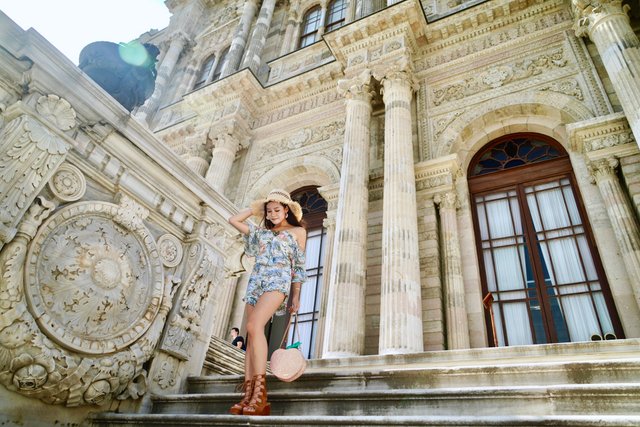
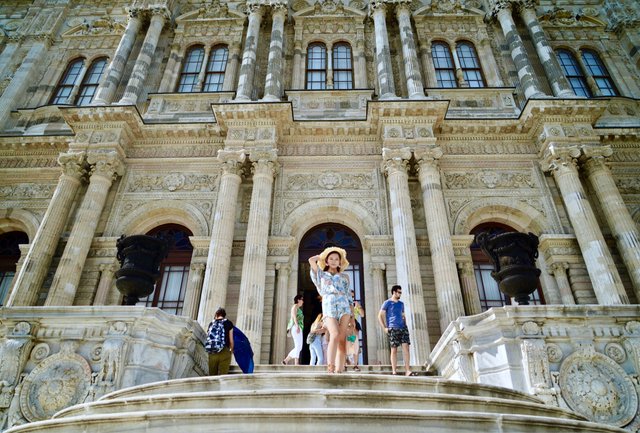
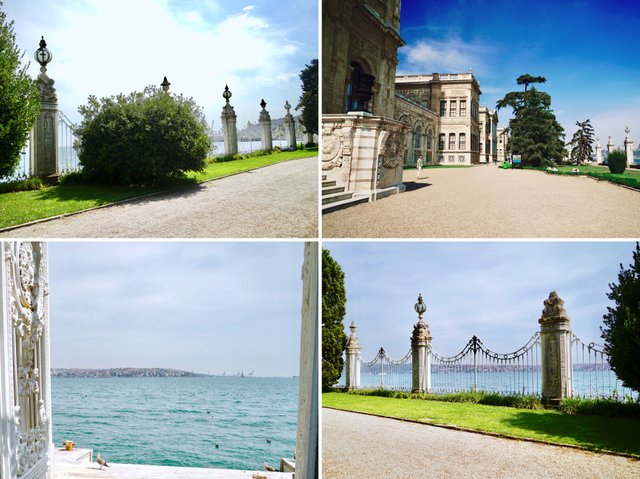
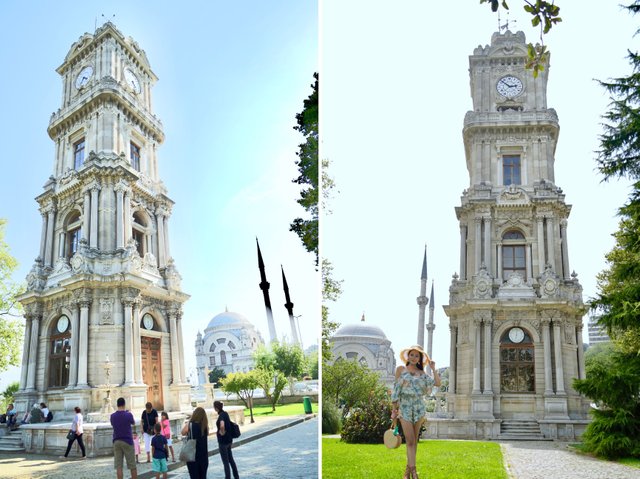
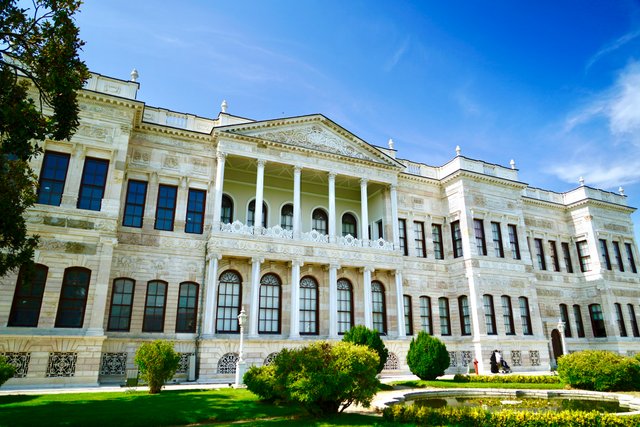
Within many of these buildings would have lived the Sultan and his close relatives. However, there were also guards, servants and many others living within the palace to serve the Sultan and his family. For example, the palace had two kitchens, one just for the Sultan and one for everyone else. According to my guide there would have been multiple head chefs, in charge of different areas of the kitchen. The head chefs would have 60 chefs beneath them, with 200 assistants to help them. And that was just to make the food! Let alone set the tables, clean the linen, serve the meals and clear the tables. I love food but... even I can't imagine that many people cooking me a meal!
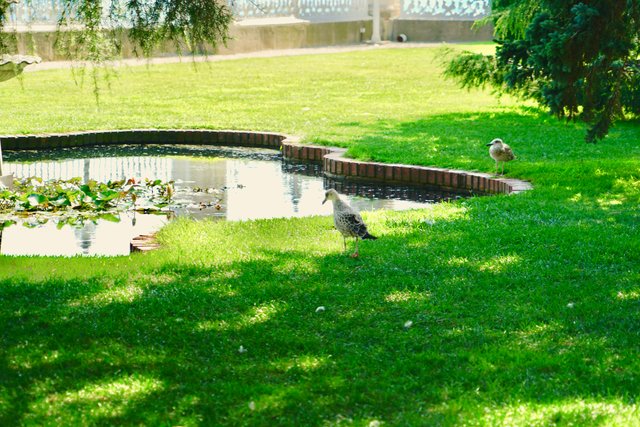
The tastes, sounds and smells of Byzantion Bistro Restaurant
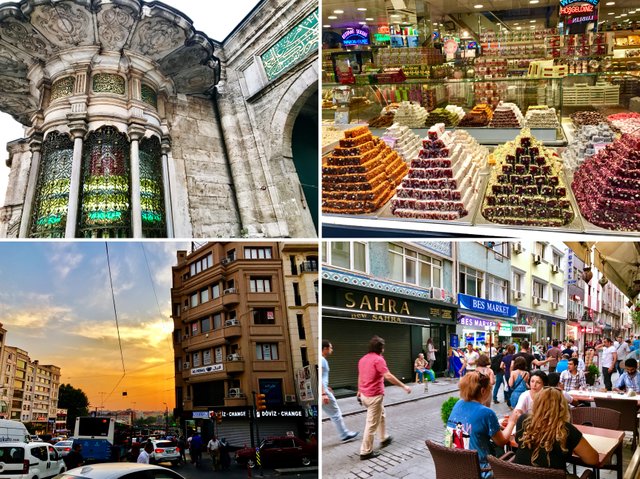
Upon leaving the Dolmabahçe Palace I suddenly felt very hungry so went in search of some local Turkish cuisine, as you know is a favourite of mine. Winding through the streets of Istanbul I realised just how quiet and tranquil it had been within the walls of the palace and its grounds. Istanbul is a place of noise, hustle and of course, bustle. It's a place you could easily get lost in, and would enjoy every minute of being lost.
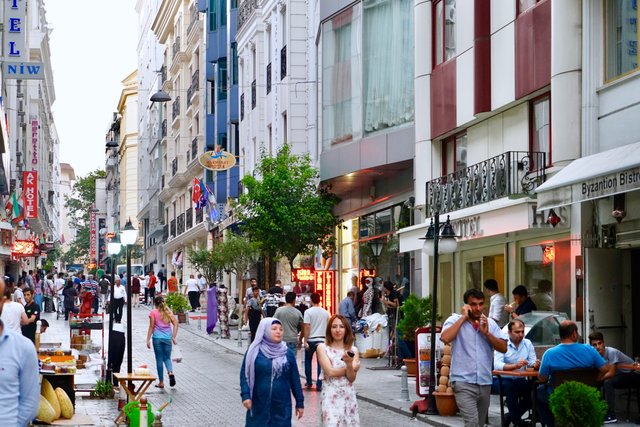
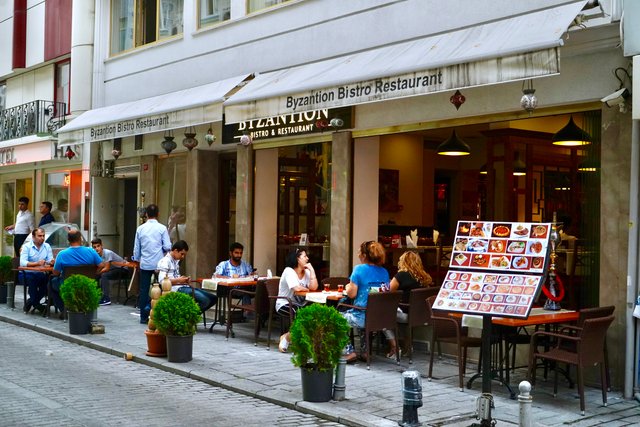
Istanbul has a population of over 15 million people, so it's not difficult to find somewhere to eat. I'd been recommended this restaurant by a friend, which was great because there was so much choice that it was easy to become overwhelmed.
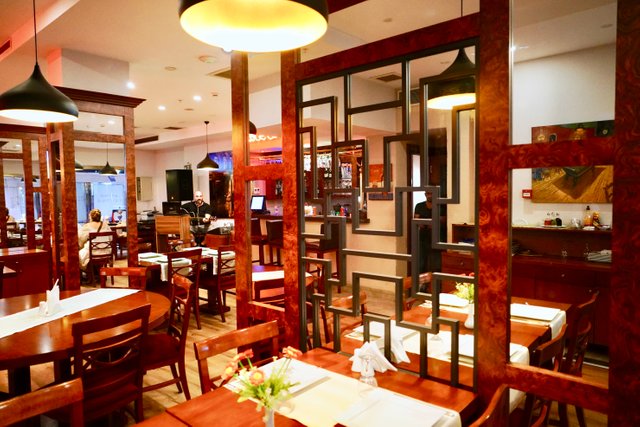
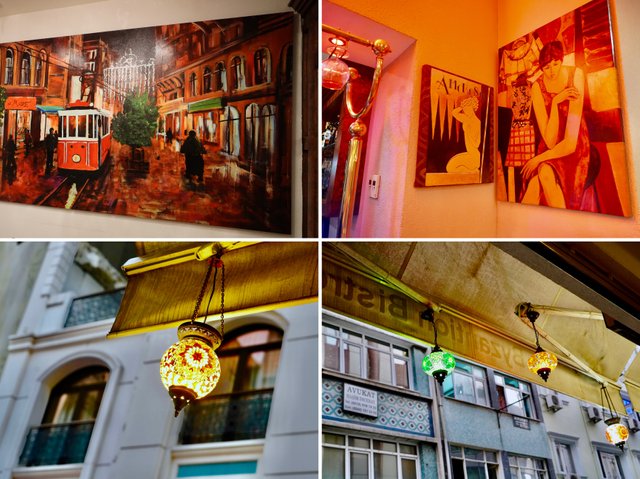
I got to the restaurant for a very early dinner so it was nice and quiet, but there was already some live music playing and that gave the place a lovely relaxed atmosphere. I love the design of the place, with lots of little features, pieces of art and open dividing walls which help break up the place a bit. Though it felt like styles had collided from a number of different influences, I think that felt 'right' in a place like Istanbul, that has been a melting pot for cultures and peoples for thousands of years.
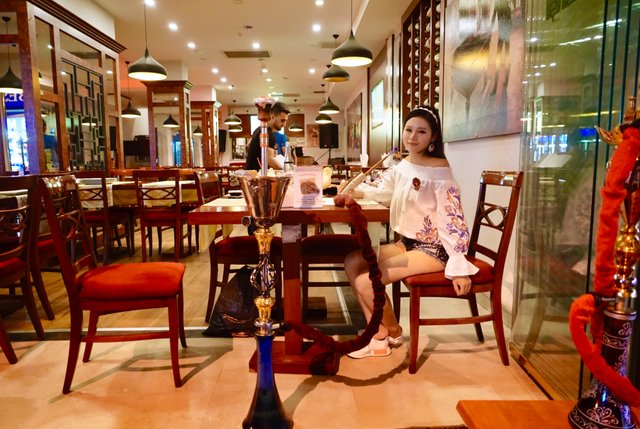
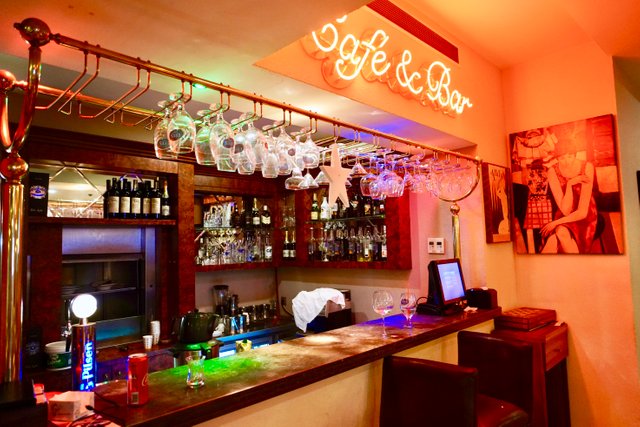
Byzantion Bistro Restaurant offers a bit of everything, from coffee and tea, to drinks from the bar, to Hookah at your table before dinner! With the front of the restaurant open, and a table right at the front, it was lovely to pass the time while waiting for my meal, people watching. I have to say though, the smells coming from the kitchen had my tummy rumbling!
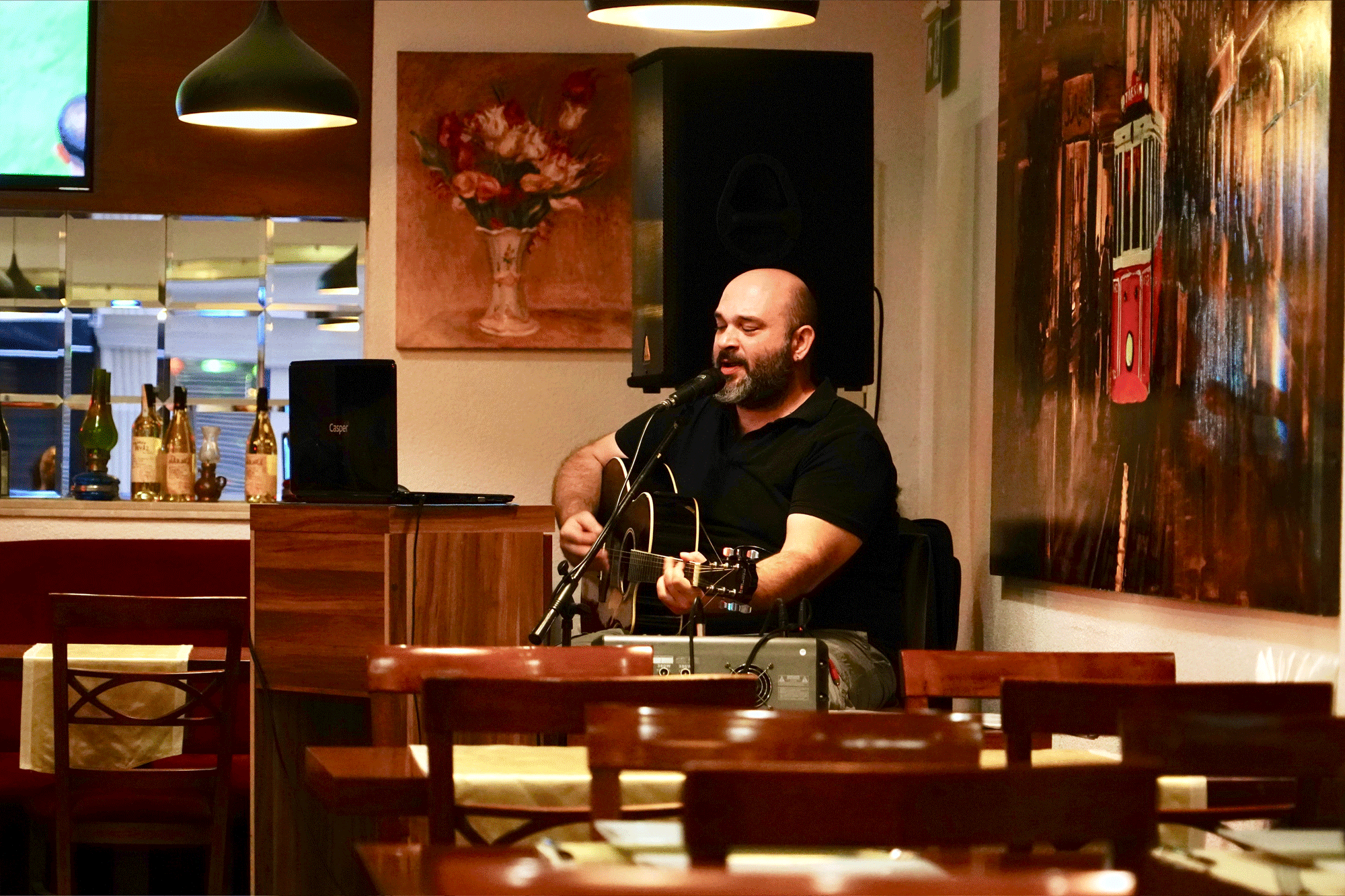
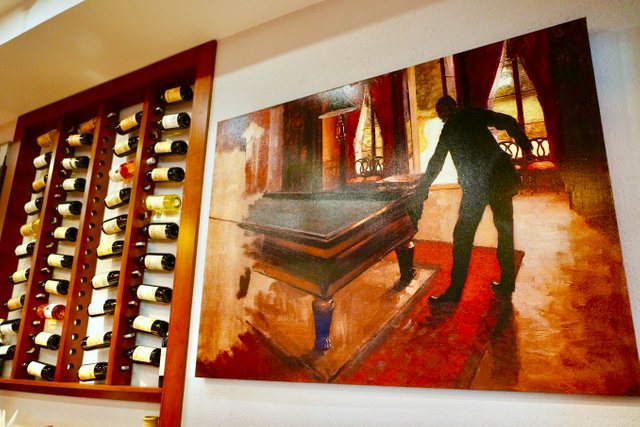
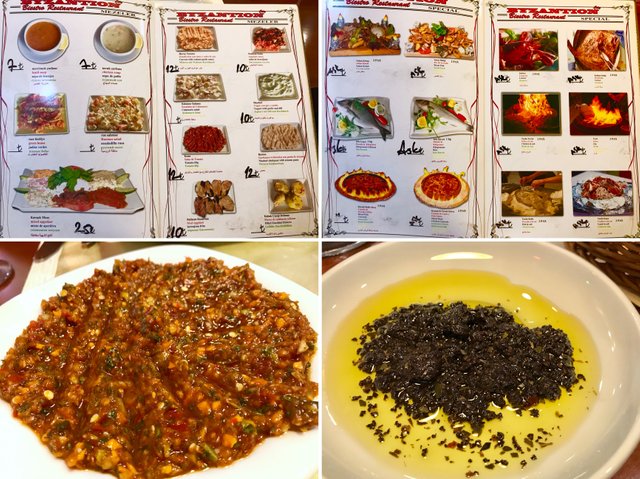
If you've been following me recently, you'll know the I absolutely adore Turkish food. It's fresh and fragrant and I just love it. So when presented with a menu full of so many appetising and beautiful dishes, it was very hard to choose! I didn't really know what I wanted, so I actually asked the waiter to bring me a little bit of some of the chef's favourite dishes. What you see here is the banquet he lavished me with and trust me, it was lucky that I was hungry!
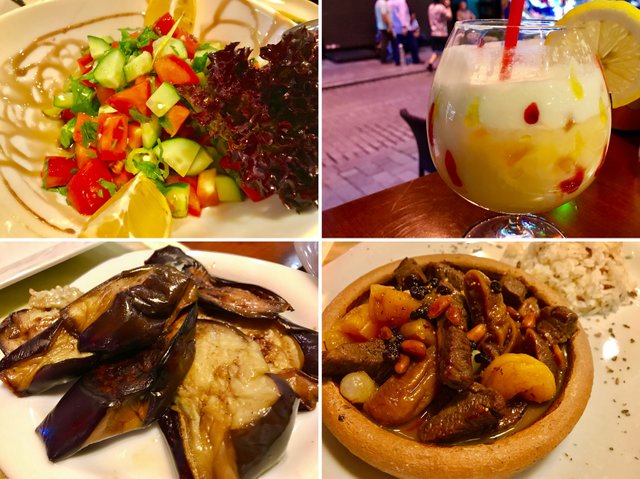
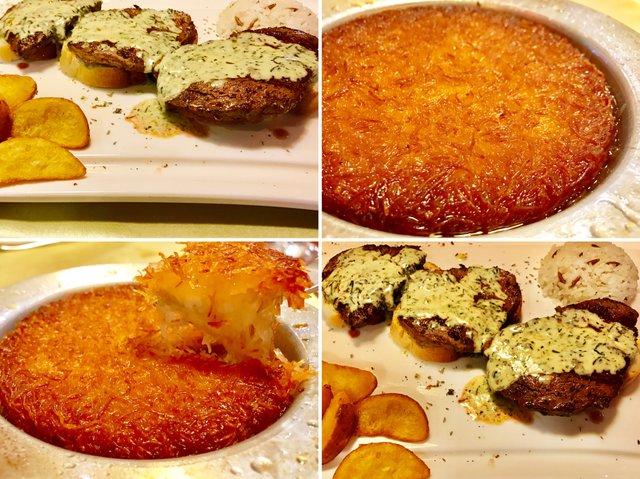
My dear Steemit friends, I don't know how I've come to the end of another blog. Time absolutely flies when I get down to writing these for you because I just love exploring the places and working hard to explore them through my words and photos for you. I really hope you enjoyed the tour around the Dolmabahçe Palace - Abdulmecid I certainly knew what he was doing when he commissioned such a stunning place. He wanted to create a place that would rival any of the palaces from Western Europe, and he definitely did that!
Which was your favourite picture from today? There were so many shots of the palace that I really found it difficult to choose just a few. Each angle showed something new and the harder I looked and the closer I examined the stone work, the gates and the gardens, the more there was to discover about the craftsmanship that must have gone into creating this giant work of art, called Dolmabahçe Palace.
If you're new here and want more content like you've read today, and want to see more from me, then hit that follow button. I post regular travel and food blogs and I'd love to have you here with me. I read all of the comments from all of my friends here and it's always a pleasure to catch up with you all and hear your thoughts on my travels! Thank you for hitting that vote button and I can't wait until next time already!
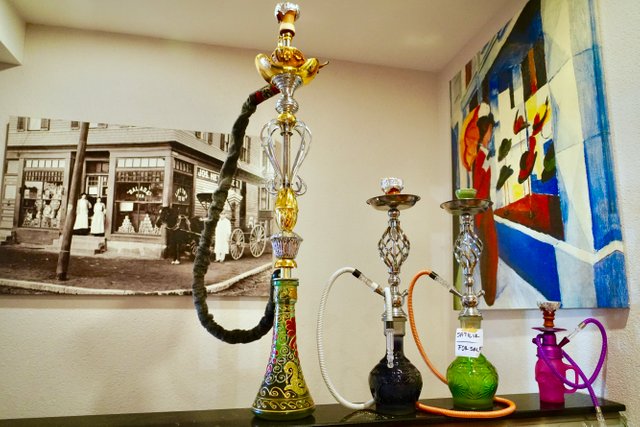
Make sure you check out my video tour, including my Bitcoin 10 year anniversary dance!
总觉得伊斯坦布尔是一座神秘又充满奇迹的城市,在城市中漫步,总是能不断从其厚重的历史文化中找到惊喜。今天我就想带大家去看看多尔玛巴赫切宫,这个名字对于许多人来说也许还陌生,甚至网络上关于它的介绍并不多,但是对于我来说,这个宫殿确实是整座城市非常值得一看的景点。虽然这几年游历过的皇宫的确不少,但是这一座最让人影响深刻,当我早前偶然间看见多尔玛巴赫切宫的照片,我的心已经深深被它吸引,这是一座拥有“大海之门”的皇宫。
宫殿里的“大海之门”
从没有想过建在海边的宫殿可以这般的温婉清新,从博斯普鲁斯海上望向多尔玛巴赫切宫,就像海面上升起一颗璀璨夺目的珍珠。多尔玛巴赫切宫建在博斯普鲁斯海峡的欧洲海岸边,绵延600多米,而曾经让我魂牵梦萦的那张照片的主角,就是这座建在海水边的宫门。面朝大海的皇门所散发的迷人魅力给了我意外的惊喜,洁白无瑕的白色大理石门柱后面是博斯普鲁斯海峡的蔚蓝海水,午后的阳光温柔的穿越皇宫大门,投射出天堂般圣洁无瑕的光芒,洒在宫殿花园里的每一处角落。我闭上眼睛,想象着自己如皇宫贵族一般悠闲地散步,慵懒的晒着太阳,吹着海风,看着蓝白色纯粹的美景,会是怎样天堂般的享受呢?
宫殿的历史与奢华
多尔玛巴赫切宫始建于1843年,1856年完工,它是奥斯曼帝国从1856年至1889年,以及1909年至1922年的主要行政中心。也是在奥斯曼帝国时期,仅有的巴洛克和新古典主义风格相融合的一座皇宫,被人们称为新皇宫。历史上记载着奥斯曼帝国最后的6位苏丹以及伊斯兰教领袖阿布都麦吉德曾住在这座宫殿里。宫殿占地25万平方米,其中的建筑可以说是极尽奢华,光是建筑工程就耗费掉了500万奥斯曼金磅,相当于35吨黄金1亿美元,并且也有14吨黄金,40吨白银用于制成金箔银饰装点宫殿的天花板。不禁让我联想起慈禧太后修建颐和园的往事。
这样难以用言语形容的奢华富丽景象,欧式宫廷样式建筑风格,仿佛是融合了法国卢浮宫、英国白金汉宫与土耳其建筑风格的“奥斯曼复兴式”皇宫,又怎么会出现在民俗风韵和东方风格皆突出的国家呢?据说是十九世纪奥斯曼帝国第31任苏丹奥斯曼帝国苏丹阿卜杜勒-迈吉德访欧后,感觉自家东方风格的老皇宫太土气也过于简陋,便下令填海造陆后修建了这座新宫,而多尔玛巴赫切正是意为“填海而造的花园”。
从海上的视角望向宫殿,也可以清晰的观赏到皇宫所分作的三个部份,左边是赛拉姆勒克宫,中间则是中央大厅,右边是后宫。走在皇宫气派豪华的庭院内,一派安逸祥和的气息,感觉世间万物都瞬间变得美好起来。走过这座由鲜红色城墙搭建的白色大理石宫门,眼前的景色再次变换,被照顾得精美绝伦的园艺艺术展现在眼前,让我喜出望外。坐在宫殿花园里的草坪,享受着被修剪工整的花草在身边绽放,这些无比鲜艳的红花绿草,远处湛蓝深邃的海水,没有想到此地此景,可以把大自然的颜色描绘的这般美好。花园里我也找到了狮子雕像,还有土耳其民俗风味的花瓶布景,草坪中央一条铺满银灰色大理石地砖的大道将我指引到了一个修砌的如同绽放花朵的喷水池,我在宫殿前的异形喷水池旁坐下,享受着皇家园林里那一份久违的惬意。
走进宫殿内部
也是因为多尔玛巴赫切宫在设计理念上及其崇拜西式风格,无论是建筑的外观还是内饰都极为欧化,我认为其富丽奢华的程度甚至都超越了欧洲任何一座皇宫。说到这里,我想你们和我一样已经迫不及待想走进宫殿内部,欣赏一下那些让人叹为观止的奢华。宫殿内部的开放有时间的限制,一般在下午四点之后就会关闭。并且宫殿内部的盛况一般不允许拍照,所以我只好睁大眼睛好好用心享受里面的美丽。因为这座宫殿是建在填海而成的地基上,所以为了减轻建筑自重,主体采用了从马尔马拉海运来的白色大理石及埃及雪花石建造,还有从贝加蒙古城运送而来的红斑石,室内装潢和照明都是意大利和法国艺术家设计的。宫殿共有285个房间,43处厅堂和6个土耳其浴室。
内部的珍宝更是令人目不暇接,豪华的水晶灯、象牙、黄金、珠宝、玉器制品,装饰摆设甚至连窗帘都是世界各国的皇室送的珍品,穿梭在迷宫般大大小小的会客厅里,处处可见黄金点缀的大理石门框和吊顶,刺绣精致华丽的超大地毯,精美瓷瓶还有名贵的油画比比皆是,其中那颗世界上最大的4500公斤重的巨型水晶吊灯更是让人嗔目结舌,给我留下了奢靡已极的深刻印象。更是因为这个水晶吊灯,多尔玛巴赫切宫又被称为水晶宫。
在宫殿的每一处角落我都感受到了崇欧情结的痕迹,内部虽有意大利文艺复兴及巴洛克风格的装修,但又是按传统的奥斯曼十字平面布置的,可以说是多元文化相融合的结晶。透过新皇宫内部的窗户可以看到海,波澜诡谲的蓝蓝深海和云雾覆盖的海峡,仿佛畅聊着如同波澜迭起的奥斯曼帝国的过去,浓重的历史感油然而生。
只可惜这般气势恢宏、绚丽多姿的美景背后,却不知累积着多少沉痛可悲的代价。据说为了建造多尔玛巴赫切宫,奥斯曼王朝投入了大量的资金,并为此欠下了大量的外债。尽管皇宫透露出曾经盛极一时的奥斯曼帝国的辉煌,却与后来奥斯曼帝国国力的衰落形成了鲜明的对比。踩在摇摇晃晃的木板上,注视着独自华丽的房间,却透出一股昏暗落寞的气息,放佛可以看穿奥斯曼帝国的衰落。的确,在奥斯曼帝国日落西山的年代,这座奢华的新皇宫似乎耗尽了帝国最后的财富和元气。
宫殿中的独特发现
在宫中,我还发现了有趣的几处,比如宫中的钟表不曾走动,原来是为了纪念国父阿塔图尔克在工作中与世长辞,于是宫中所有钟表都把时间定格在了那一刻,也从此把这座宫殿正式作为博物馆对外开放。由于之后的年代少有战乱,皇宫内基本未遭破坏,所有的摆设物件都是真品,窗帘、地毯也都是当年的铺设,并且还原了皇帝生活工作的场面,让人可以感同身受宫殿里的生活气息和亲切的一面。除此之外,大厅里高耸的柱子竟然是中空的,原因是能在寒冬注满暖气,从而为室内供暖。在众多让人目不暇接的王室珍宝中,让我印象最为深刻的是一部打开的书本状餐具匣,各种勺叉收纳其中,多么特别的设计元素。走进主厅,简直是西式优雅和土耳其式艳丽的完美结合,满眼充斥着丰满辉煌的装潢,让我心跳加速,那种因为富丽堂皇而被震撼了的感觉,几乎让我一时间忘记之前看过的其他西方宫殿。在出门的地方,我还和宫殿大门旁高耸的钟塔合影,就这样念念不舍的离开了这座如同梦一般,优雅梦幻的海边宫殿。
街边的现场音乐餐厅
在夜色降临时分,我选择徜徉在街边悠扬乐声中结束一天的行程。这一家餐厅Byzantion可以让你在享受美食之余,还有时而温柔时而激昂的男女主唱演唱土耳其民俗歌曲,当然还可以尝尝当地最地道的水果味水烟,当然味道再好也不要贪烟嘛,尝鲜即可。土耳其的凉菜里我最喜欢其浓郁的酸甜酱料,无论烤茄子还是烤肉,这家餐厅都做的非常地道,不愧在旅游点评网站猫途鹰上夺得美食头衔。最让我惊讶和难忘的是在饭后,餐厅招待的甜品库内法,比起其他土耳其甜到腻的甜食,我认为这道土耳其甜品最容易让人接受。库内法放在古典铝制盘子里,酥脆的外皮搭配Q弹的起司,融合了面粉小麦糊,内陷浸入酥脆的糖浆,最后撒上开心果粉,一口送入嘴里仿佛融合了所有甜蜜的元素。今天的伊斯坦布尔新皇宫和音乐美食之旅就要告一段落了,之后还有更多精彩的旅游日记想要和大家分享。
Amazing photos!
美丽的地标和令人惊叹的照片
Beautiful Landmarks and Stunning Photos
Translated by Google
Love it all!
markvance thank you!! :)
These are some of the highest quality posts on this entire platform. Every time you post, you make the places you visit look amazing! The images are all incredible but the one with you on the grass with the castle in the background is my favorite.
Hanshotfirst thank you so much ! I think I prefer to write about the experiences I find most memorable so that might be the reason why it sounds amazing!
我也去过那个宫殿 但没拍到这么多完整的照片 介绍得好详细 感觉这次的照片风格有点不一样呢 换相机啦?
我干嘛总这么好奇🤓哈哈,谢谢啦,相机没有换,只是为了配合宫殿,换了一种调色的风格啦^^
I've drawn some steemit celeb bloggers. You are one of them. What do you think? It's animated
this looks really cool doelist, thank you so much!
Oh, thanks))
Amazing travel diaries ;) God bless you !
thanks zainabali, do follow for more!
I really want to go to Turkey one day.
It's always cool to see that you post in two languages.
I love this photo @sweetsssj, Beautiful.^_^
the place of The Dolmabahçe Palace of Istanbul is truly amazing to me.
how I wish to go there also.^_^
take care always and super thumbs up
for my support Upvoted and resteem ^_^
Thanks mrblu, you're like my picture editor picking out the ones people might have skipped over. Good job!
thanks sweet its an honor to be one of your fans.